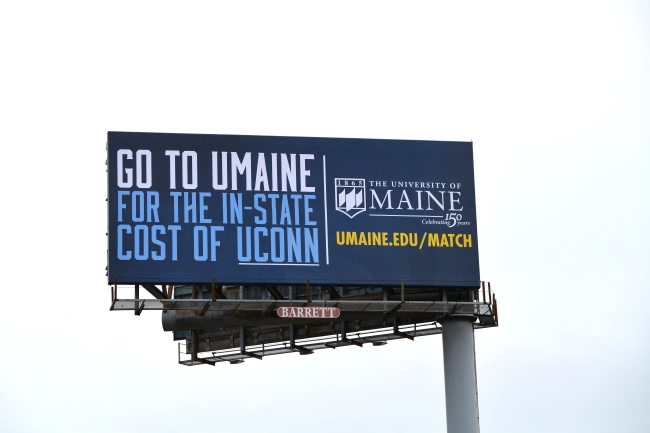You have /5 articles left.
Sign up for a free account or log in.

University of Maine billboard in Connecticut
University of Maine
A brazen University of Maine effort using tuition matching to thrust itself into the conversation with six larger and more widely known Northeastern public universities paid off with a 54 percent increase in out-of-state freshman commitments for the fall.
But nearby flagship universities that Maine tagged with bull’s-eyes say they haven’t felt an admissions loss. And Maine hasn’t reported a major change in the academic chops of students committing to its campus in the town of Orono. Ultimately, the tuition-matching campaign put Maine on the map for more out-of-state high schoolers -- it just doesn’t appear to have siphoned students straight from other states’ more selective flagships.
That’s not to say the program is without its areas of strength or potential downsides. Like many campaigns to boost out-of-state enrollment at public universities, it’s set to bring in a new source of cash -- more higher-paying students -- to a state with a declining population and a university system in a financial crunch. Maine's strategy seeks to do so while standing out for trying to snag students at an in-state price point, rather than far higher out-of-state rates.
Geographically, Maine's program was clearly most successful in drawing students from Massachusetts. Yet while it helped drive a spike in first-year applications, that spike prompted Maine to put in place its first universitywide wait list in recent history.
The results are different from what casual observers might have guessed when Maine debuted the program, called Flagship Match, at the end of November. The outspoken campaign caught attention for flashy billboards promising lower-than-normal rates to out-of-state students from nearby states. Flagship Match specifically pitched students in Connecticut, Massachusetts, New Hampshire, New Jersey, Pennsylvania and Vermont on the prospect of attending Maine for the same cost of the quoted in-state tuition and fees at their home states’ flagship universities.
In other words, Maine offered merit awards for out-of-state students in amounts pegged to rates at other states’ flagships. For example, Maine, with its out-of-state tuition and fees listed at $28,880 per year for 2015-16, would offer Flagship Match awards worth $14,709 for Massachusetts seniors who had a high school grade point average of at least 3.0 and SAT scores of at least 1050. That would bring the cost of attending Maine in line with the University of Massachusetts at Amherst’s quoted in-state tuition and fees of $14,171. Prorated awards were also offered for students not meeting criteria for the headline award.
An important point is that even after the flagship discount, out-of-state students will be paying more to attend Maine than those from inside the state because all of the flagship targets charge more than Maine. Maine’s in-state tuition and fees totaled $10,610 in the current academic year. Maine lists the Flagship Match program as renewable for up to four years and said it will adjust award amounts to reflect tuition rates released for 2016-17.
The efforts boosted out-of-state commitments as of May 1, Maine reported. A total of 1,123 out-of-state students sent in deposits by the date, up 54 percent from 731 a year ago.
Deposits from Massachusetts spiked 81 percent, to 518. Maine increased its commitments from its five other target states as well, but to a much lesser extent. Commitments from Connecticut rose 33 percent to 122, and commitments from New Hampshire jumped 40 percent to 102. Commitments increased 37 percent, to 71, from New Jersey; 22 percent, to 39, from Vermont; and 35 percent, to 31, from Pennsylvania.
Leaders at Maine hadn’t completed their analysis of why the increase was higher in Massachusetts than elsewhere. Maine didn’t purposefully blitz Massachusetts with more marketing than the other states, said Provost Jeffrey Hecker. But Massachusetts previously sent the most students to the University of Maine, so this year’s deposits were growing on an existing platform.
“I think some of it is proximity,” Hecker said. “A lot of people in Massachusetts associate the state of Maine with a vacation. And part of it is it’s a bigger population.”
At a higher level, the gains prove the tuition-matching strategy and its accompanying marketing worked, Hecker said. Maine paired the Flagship Match program with ramped-up out-of-state recruitment, including outreach to guidance counselors and billboards in Northeastern states. The university formed the strategy after finding through research that more than 97 percent of students who applied to Maine but decided not to attend enrolled out of the state. A quarter of those students were going to other land-grant universities, mostly in New England.
The increase in out-of-state enrollment didn’t lead to large-scale changes in Maine’s other undergraduate indicators. SAT scores dipped slightly, with the incoming class’s median score down about 10 points from last year’s, to 1070. Diversity at the university, which has traditionally drawn a relatively low level of minority students, ticked up. Maine’s incoming class has 53 percent more African-Americans than its 2015-16 freshman class, 66. It has 49 percent more Hispanic students, 115. Those numbers are for the entire class, not just out-of-state students, but the bump up was driven by out-of-state increases, Hecker said.
However, discount rates were largely unchanged. Even after taking Flagship Match into account, the discount rate for out-of-state students is on track to be about 38 percent, a decrease of less than a percentage point. The discount rate for in-state students jumped by about the same amount.
“We certainly have not been spending more per out-of-state student,” Hecker said. “We’ve been pretty targeted. I think we’ve got a certain kind of student who’s coming here, and the financial aid we’re able to offer and their backgrounds make this affordable.”
Maine admitted 17 percent more students this year -- 11,590 as of May 1, up from 9,930 the previous year. Most of the increase was from out-of-state students. Non-Maine residents admitted shot up 24 percent to 7,910, from 6,362.
The Flagship Match program called out another New England university known for its out-of-state recruitment: the University of Vermont, in Burlington. But Maine leadership said their university is not modeling recruiting efforts after Vermont, which has less state support and draws between 70 and 75 percent of its students from beyond its borders. Even with the increase in out-of-state students, Maine’s committed freshmen are 54 percent in-state students.
There are other differences between the two flagship universities, said Stacey Kostell, Vermont’s vice president for enrollment management. Vermont surveyed admitted students last year who opted to go to Maine instead of its campus, she said. It found very few, meaning Maine didn’t register as a top competitor like some other universities -- the University of Massachusetts at Amherst, the University of Connecticut, the University of New Hampshire and even the University of Colorado. Vermont has built its recruitment strategy around a larger area, including the Northeast, the Mid-Atlantic and other high-growth regions.
Kostell pointed out many students will still have a price incentive to stay in-state, even though the Flagship Match program walks a line between courting out-of-state students on price and still charging those students higher rates than Maine residents pay. Vermont can undercut Maine’s promised discount by offering in-state students aid, dropping costs below quoted prices, she said.
“Some students may pay full tuition, but there’s many who may receive some form of aid,” she said.
Kostell wasn’t the only admissions officer at a flagship targeted by Maine to report no noticeable hit to recruiting efforts. Many said they were aware of Maine’s matching program and keeping tabs on it. But they added that they couldn’t attribute any lost students to it.
Nathan Fuerst, assistant vice president for enrollment and director of admissions at the University of Connecticut in Storrs, reported receiving 36,000 applications this year, with a record number coming from in-state high schools, nearly 13,000. Connecticut had yet to release deposit figures, but Fuerst said it’s nearing its largest-ever intake of in-state high school seniors.
“We’re capturing a larger share of a shrinking pie,” Fuerst said. “I don’t think they’re stealing students from us.”
Students surveyed have never indicated they’re deciding between the Connecticut flagship and Maine, Fuerst said. Maine may be picking off a few students from many different colleges, he said. Or it’s possible Maine is seeing its out-of-state bump from other, smaller public institutions.
“There are four other smaller liberal arts public universities,” Fuerst said. “My instinct would be that’s perhaps where they are getting their increase.”
Nor did the Maine numbers take a bite out of the University of Massachusetts at Amherst’s applications. Applications to that state's flagship rose by more than 900 this year, to a new record level of 40,913. The university did not yet have data on deposits, said spokesman Ed Blaguszewski.
“We’re confident we will have a strong year and continue to recruit outstanding students here at UMass Amherst,” he said.
Farther north in Massachusetts, and closer to Maine, the University of Massachusetts at Lowell was not admitting to any losses from the tuition matching program, either. The university received 1,518 in-state deposits and 248 out-of-state deposits.
“UMass Lowell has seen increases in both applications and deposits from Massachusetts residents for fall 2016,” said spokeswoman Christine Gillette in an email. “In-state deposits are up 8 percent and we are on track to enroll our largest-ever freshman class, which will also have the highest average high school GPA and SAT scores in university history.”
Regardless of where the new out-of-state students are being drawn from, Maine’s administration is happy to see them coming. Maine’s universities face challenges in a state with the oldest median age in the country and a falling high school population, said University of Maine President Susan Hunter. The university saw a chance to stem the bleeding after tracking its out-of-state students and finding that, over the last five years, 22 percent of graduates stayed in the state.
“Frankly, we need to import people of a younger age demographic to become the educated workforce in the future,” Hunter said.
Even so, Maine heard some negative feedback from families concerned about in-state students being bumped by out-of-staters. Provost Hecker acknowledged applications jumped more than expected this year, from 12,500 to 14,600. The university took some criticism when it instituted its wait list in March after accepting more than 11,000 students for a class expected at the time to total 2,150.
“We’ve heard from some guidance counselors and families saying, ‘My son or daughter and my student is very strong,’” Hecker said. “The reality is, we offered people a wait list. Less than half the people who were offered it chose to go on. We’re reviewing that.”
Students on the wait list were being contacted starting May 6, according to Hecker. Maine’s flagship expects to admit a small number of students to specific majors with capacity. All wait-listed students meeting admission criteria automatically gained acceptance at five other University of Maine System campuses.
The flagship’s administration also pointed to an increase in deposits from in-state students this year. Maine received 1,324 deposits from in-state students, up 3 percent. That brought the incoming class to 2,447.
The co-chair of the Maine State Legislature’s Joint Standing Committee on Education and Cultural Affairs is backing the Flagship Match efforts. Republican State Senator Brian Langley said Maine graduates 12,000 high school students every year, which isn’t enough to keep its universities afloat. The Flagship Match program has captured attention while aiding Maine’s finances, he said.
“I think to some degree, the University of Maine is starting to get in the heads of students a little bit,” Langley said. “To go out of state and advertise that the University of Maine flagship will accept you at your in-state university tuition, which splits the difference between our out-of-state tuition and our in-state tuition, it’s a win-win.”
The university’s administration plans to continue the Flagship Match program in the future. It will look at possible modifications over the summer that could include raising standards.




